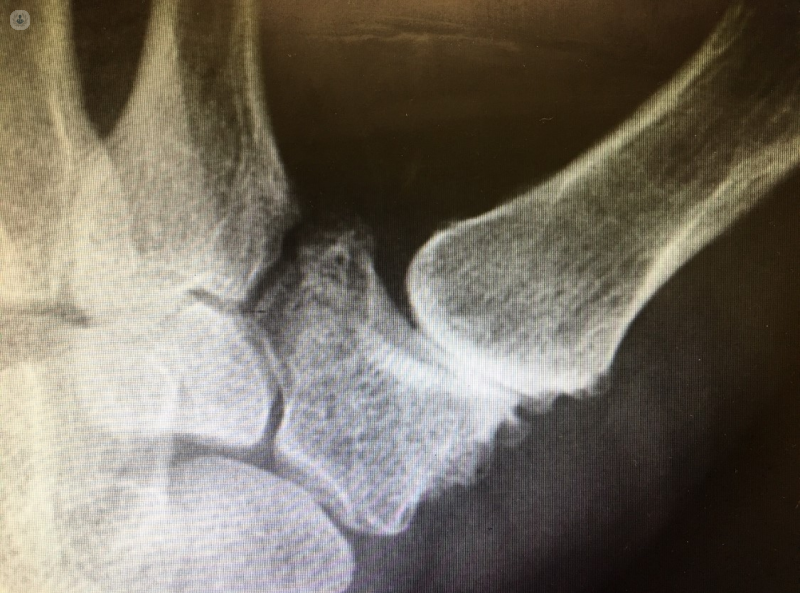Surgery is not the only answer – non-surgical treatment for thumb arthritis
Escrito por:Pain at the base of the thumbs can make simple things a real challenge. Undoing jar lids and soda bottle tops, fiddling with buttons, lifting saucepans – everyday actions that were no trouble yesterday can find us asking for help today without any rhyme or reason. What’s going on? Expert orthopaedic surgeon Miss Tanaya Sarkhel has the answers.

One of the most frequent reasons for a painful pinch and power grip that I see in clinical practice is wear and tear between the bones at the base of the thumb (basal thumb arthritis). It is not surprising, given that a decent pinch grip can generate 120kgs of pressure across a small surface area of about 1cm2 and this is an activity repeated so many times over a lifetime.
Cartilage covers the ends of bones and provides a friction-free surface for our joints to glide over. It behaves a bit like a memory foam mattress, deforming and bouncing back as different pressures are applied but as we get older, cartilage starts to age as well and becomes a bit less resilient to the forces generated in our normal activities.
This means that tasks which require repetitive or a prolonged pinch grip may result in aching around the base of the thumb. This thumb joint pain may come on a little while after the stressor event, or at night, and it may not be immediately obvious as to what has brought it on.
Identify
So what should you do if this is happening to you? The first step is to identify the cause of the thumb pain. You may already have found that to ease discomfort you are holding the sore area or have tried anti-inflammatory creams or gels to the side of your wrist that sits at the base of your thumb. This is where the inflamed joints sit.
Besides thumb arthritis, there are one or two other things that could cause pain in a similar area (such as tendonitis or ligament injury) and a healthcare professional will be able to help you work out what’s going on and may take an X-ray to confirm the diagnosis.
Adapt
Look at your activity and see what steps you can take to adapt and offload the worn areas. Writing may be easier with a fatter pen barrel and a felt tip or roller ball require less pressure than a biro. If you are gardening, use your secateurs with gloves and only for 10-15 minutes at a time. Sewing and knitting may also aggravate; breaking these activities up into short bursts, doing something completely different in between will help to give the joints a rest. In the kitchen don’t be shy to use aids to open jar lids or cans, and double-handled saucepans may be safer to drain than the traditional design.
One of the issues with arthritis at the base of the thumb is that because the joints are worn, they no longer move through their original range of movement. The thumb sits at 90o to the rest of the palm, but for most of our lives we have been able to place our palms flat down on a surface and even drive weight through them, for example for press-ups, getting up out of a chair or pushing ourselves up out of the bath.
When the joints at the base of the thumb wear, they also stiffen, and these activities start to become painful. You don’t have to give them up though: if you want to do press-ups or yoga poses, you can still do them on clenched fists or through your elbows. You can imagine, however, if you take a tumble and you put the flat of your hand out to stop yourself, you’ll be forcing a stiff joint into a position it really doesn’t like and the pain can feel so sudden and persistent that you may wonder if something’s damaged.
Support
A number of wrist and thumb supports are available – the best ones isolate the thumb and are low profile, leaving the wrist free to move. They can be expensive, so before committing to purchasing one, take advice to confirm they would be appropriate for you.
Analgesia
If you are able to and it is safe for you to take it, anti-inflammatory medication such as ibuprofen may shut down a painful episode. If you find, however, that you are reaching for tablets more frequently than just now and again, you may need something longer lasting.
Steroids (cortisone, corticosteroid) are one of the most powerful anti-inflammatories we have in our armamentarium. When given as an injection directly into a joint, they don’t go anywhere else in the body, but target inflammation where they’re given. We usually arrange for injections into the thumb joints to be delivered under ultrasound guidance, as these joints are very small and it is important for later decision-making to be certain it goes in the right place. Any beneficial effects may take a few days to develop, sometimes a couple of weeks, but the resulting improvement may last indefinitely. The general advice is not to have more than three steroid injections in the same place within twelve months, as steroid can soften the cartilage that we are trying to preserve.
If all these steps no longer keep you comfortable, then it may be time for a conversation about surgical options, but as you can see, there are many things you can do that may be sufficiently effective for surgery not to be necessary at all.


